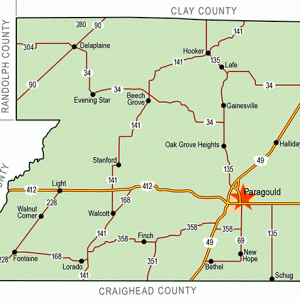calsfoundation@cals.org
Delaplaine (Greene County)
| Latitude and Longitude: | 36°14’01″N 090°43’35″W |
| Elevation: | 276 feet |
| Area: | 1.11 square miles (2020 Census) |
| Population: | 64 (2020 Census) |
| Incorporation Date: | May 8, 1912 |
Historical Population as per the U.S. Census:
|
1810 |
1820 |
1830 |
1840 |
1850 |
1860 |
1870 |
1880 |
1890 |
1900 |
|
– |
– |
– |
– |
– |
– |
– |
– |
– |
– |
|
1910 |
1920 |
1930 |
1940 |
1950 |
1960 |
1970 |
1980 |
1990 |
2000 |
|
– |
152 |
161 |
180 |
208 |
186 |
145 |
161 |
146 |
127 |
|
2010 |
2020 |
|
|
|
|
|
|
|
|
|
116 |
64 |
|
|
|
|
|
|
|
|
Delaplaine is a town in the northwestern corner of Greene County. State Highways 34, 90, and 304 intersect in Delaplaine, and several drainage ditches flow through the town to empty into the nearby Cache River. Delaplaine was formed by the railroad and the lumber industry, but agriculture, hunting, and fishing are the mainstays of the town’s economy in the twenty-first century.
The area had been inhabited for centuries before Euro-American settlement, with nearby Indian mounds containing artifacts such as stone tools, pottery pieces, bones, and charcoal from campfires. The Osage hunted and camped in the region prior to the Louisiana Purchase in 1803, and some local historians believe that a French trading post and mission were established where Delaplaine stands today. The name of the community is French, meaning “of the plain.” Originally, the name was written as three words, but the United States post office created the official spelling of the name as a single word.
About a dozen families settled in the area during the middle part of the nineteenth century. One settler, remembered only as C. G. Jones, gave his name to Jones’ Ridge, a striking geological feature near Delaplaine. In 1872, the St. Louis and Iron Mountain Railroad built a line through the area, establishing a stop at Delaplaine that was first known as Grey’s Station. Lizzie Grey received permission to open a post office at the station, making her one of the few female postmasters in Arkansas at that time. The post office was called Grey’s Station from 1872 until 1875, when it was renamed Delaplaine. A newspaper was published in the settlement by James W. Wray for a few months in 1873 or 1874.
The community did not grow as quickly as many other towns along the railroad near timber areas. Early in the twentieth century, a ten-mile tramline was built from Delaplaine to Brookings (Clay County), where the hardwood trees of the Black River valley were being harvested. This construction did lead to a growth in population, accompanied by stores, hotels, boardinghouses, saloons, a doctor’s office, and a blacksmith shop. The town was incorporated in 1912. One public school opened on Jones’ Ridge, and another in the town of Delaplaine. A Baptist revival in 1919 led to the establishment of a church built by volunteer workers on land donated by Luther Gates.
A fire destroyed a large portion of the town in 1922, burning to the ground several of the larger houses belonging to the Reed family and their neighbors; the buildings were not replaced. Around this time, the timber industry began to decline, as most of the more valuable trees had been removed. Agriculture became more important for the people who remained, and a cotton gin was built in Delaplaine. Later in the twentieth century, rice and soybeans replaced cotton in many of the fields. Four rural schools, including Jones’ Ridge, were consolidated into the Delaplaine school district in 1937. A second consolidation in 1948 enlarged the school district again at the expense of six nearby school districts. A new high school was built in Delaplaine as a result of this consolidation.
In 1974, Delaplaine built a water system for its residents. By 1984, the town had three gas stations, two general stores, a restaurant, an auto parts store, a welding shop, a farm supply store, a town hall, and a fire station. A Church of Christ had joined the Baptist congregation. Along with the school, the largest employers in the town were Riceland Foods and the Delaplaine Seed Company. However, the population of the area continued to decline. In 2004, the Delaplaine school district was consolidated into the Greene County Technical school district; grades seven through twelve ceased being taught in Delaplaine in 2008.
In 1981, the Arkansas Game and Fish Commission built Lake Ashbaugh in the Dave Donaldson/Black River Wildlife Management Area north of Delaplaine. The lake has become an attraction for duck hunting and fishing. In 2010, the town had Riceland Foods, the Delaplaine Seed Company, the Black River Mallard Resort, and the Hunt & Harvest Café, as well as the Baptist church, the post office, and an auto parts store.
Delaplaine is a childhood home of Jimmie Lou Fisher, who served twenty-two years as state treasurer of Arkansas, being one of the first women of Arkansas elected to a statewide office. In 2002, she ran for governor but was defeated in a close election by incumbent Mike Huckabee.
For additional information:
Greene County Arkansas History and Families. Paducah, KY: Turner Publishing Company, 2001.
Mueller, Myrl Rhine. A History of Greene County, Arkansas. Little Rock: Parkhurst Book Design, 1984.
Steven Teske
Butler Center for Arkansas Studies






Comments
No comments on this entry yet.